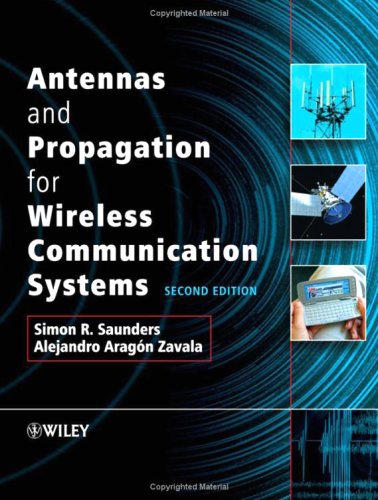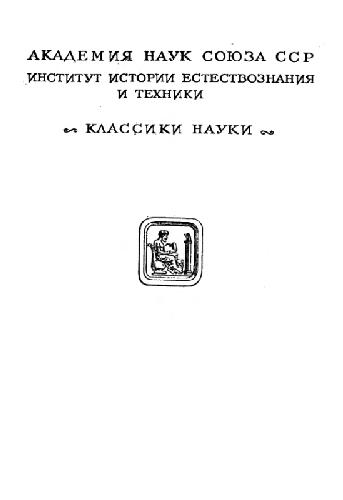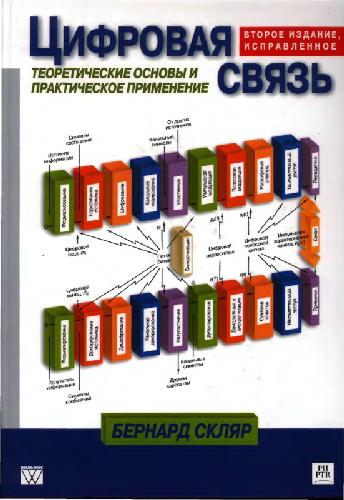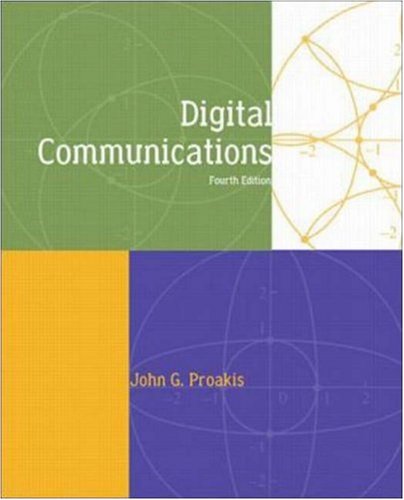Simon Saunders, Alejandro Aragón-Zavala9780470848791, 0470848790, 9781601193698, 1601193696
Including: Overview of the fundamental electromagnetic principles underlying propagation and antennas. Basic concepts of antennas and their application to specific wireless systems. Propagation measurement, modelling and prediction for fixed links, macrocells, microcells, picocells and megacells Narrowband and wideband channel modelling and the effect of the channel on communication system performance. Methods that overcome and transform channel impairments to enhance performance using diversity, adaptive antennas and equalisers.
Key second edition updates: New chapters on Antennas for Mobile Systems and Channel Measurements for Mobile Radio Systems. Coverage of new technologies, including MIMO antenna systems, Ultra Wideband (UWB) and the OFDM technology used in Wi-Fi and WiMax systems. Many new propagation models for macrocells, microcells and picocells. Fully revised and expanded end-of-chapter exercises. The Solutions Manual can be requested from http://www.wiley.com/go/saunders_antennas_2e
Table of contents :
Antennas and Propagation for Wireless Communication Systems, 2nd Edition……Page 1
Table of Contents……Page 5
Preface to the First Edition……Page 16
Preface to the Second Edition……Page 18
1.1 Introduction……Page 20
1.2 Concept of a Wireless Channel……Page 21
1.3 The Electromagnetic Spectrum……Page 23
1.4 History……Page 24
1.5 System Types……Page 26
1.6 Aims of Cellular Systems……Page 27
1.8 The Cellular Concept……Page 28
1.9 Traffic……Page 32
1.10.1 Frequency Division Multiple Access……Page 36
1.10.3 Code Division Multiple Access……Page 37
1.11 Available Data Rates……Page 38
1.12 Structure of this Book……Page 39
References……Page 41
Problems……Page 42
2.2 Maxwell’s Equations……Page 43
2.3 Plane Wave Properties……Page 44
2.3.2 Wave Impedance……Page 45
2.3.5 Lossy Media……Page 46
2.4.2 Mathematical Representation of Polarisation……Page 50
2.4.3 Random Polarisation……Page 51
Problems……Page 52
3.2.1 Lossless Media……Page 54
3.2.2 Lossy Media……Page 58
3.2.3 Typical Reflection and Transmission Coefficients……Page 59
3.3 Rough Surface Scattering……Page 62
3.4.1 Principles……Page 64
3.4.2 Formulation……Page 66
3.5.1 Principle……Page 67
3.5.2 Single Knife-Edge Diffraction……Page 68
3.5.3 Other Diffracting Obstacles: Geometrical Theory of Diffraction……Page 71
Problems……Page 76
4.2.1 What is an Antenna?……Page 78
4.2.3 Near-Field and Far-Field Regions……Page 79
4.2.4 Far-Field Radiation from Wires……Page 80
4.3.1 Radiation Pattern……Page 82
4.3.3 Radiation Resistance and Efficiency……Page 84
4.3.4 Power Gain……Page 85
4.3.6 Reciprocity……Page 87
4.3.9 The Friis Formula: Antennas in Free Space……Page 88
4.3.10 Polarisation Matching……Page 89
4.4.1 Dipole Structure……Page 90
4.4.3 Radiation Pattern……Page 91
4.5.3 The Uniform Linear Array……Page 94
4.5.4 Parasitic Elements: Uda-Yagi Antennas……Page 95
4.5.5 Reflector Antennas……Page 96
4.5.7 Corner Reflectors……Page 97
4.5.8 Parabolic Reflector Antennas……Page 98
4.6 Horn Antennas……Page 99
4.8 Helical Antennas……Page 100
4.9 Patch Antennas……Page 101
References……Page 102
Problems……Page 103
5.2 Definition of Path Loss……Page 105
5.3 A Brief Note on Decibels……Page 108
5.4 Noise Modelling……Page 109
5.5 Free Space Loss……Page 113
5.6 Plane Earth Loss……Page 114
5.7 Link Budgets……Page 117
Problems……Page 119
6.2 Path Profiles……Page 121
6.3.1 Fundamentals……Page 124
6.3.3 Ducting and Multipath……Page 127
6.4 Obstruction Loss……Page 129
6.5.1 The Deygout Method……Page 131
6.5.2 The Causebrook Correction……Page 132
6.5.4 Test Cases……Page 133
6.6 The Multiple-Edge Diffraction Integral……Page 137
6.6.1 Slope-UTD Multiple-Edge Diffraction Model……Page 138
6.6.2 Test Case: Comparison of Multiple Models……Page 142
6.7 Diffraction Over Objects of Finite Size……Page 143
6.8.1 The Integral Equation Model……Page 145
6.8.2 The Parabolic Equation Method……Page 147
6.9 Influence of Clutter……Page 150
References……Page 151
Problems……Page 153
7.1 Introduction……Page 155
7.2.1 Attenuation……Page 156
7.2.2 Rain Attenuation……Page 157
7.2.3 Gaseous Absorption……Page 162
7.2.5 Tropospheric Scintillation……Page 164
7.2.6 Depolarisation……Page 167
7.2.7 Sky Noise……Page 169
7.3 Ionospheric Effects……Page 171
7.3.1 Faraday Rotation……Page 174
7.3.3 Dispersion……Page 175
7.4 Satellite Earth Station Antennas……Page 176
References……Page 177
Problems……Page 178
8.2 Definition of Parameters……Page 179
8.3 Empirical Path Loss Models……Page 180
8.3.1 Clutter Factor Models……Page 181
8.3.2 The Okumura-Hata Model……Page 183
8.3.4 The Lee Model……Page 185
8.3.5 The Ibrahim and Parsons Model……Page 186
8.3.6 Environment Categories……Page 187
8.4.1 The Allsebrook and Parsons Model……Page 188
8.4.2 The Ikegami Model……Page 189
8.4.3 Rooftop Diffraction……Page 190
8.4.4 The Flat Edge Model……Page 191
8.4.5 The Walfisch-Bertoni Model……Page 194
8.4.6 Cost 231/Walfisch-Ikegami Model……Page 196
8.5.1 ITU-R Recommendation P.1411……Page 197
8.6 Comparison of Models……Page 198
References……Page 199
Problems……Page 201
9.2 Statistical Characterisation……Page 202
9.4.1 Edge of Cell……Page 204
9.4.2 Whole Cell……Page 207
9.5 Location Variability……Page 210
9.6 Correlated Shadowing……Page 211
9.6.1 Serial Correlation……Page 212
9.6.2 Site-to-Site Correlation……Page 214
References……Page 220
Problems……Page 221
10.2 Baseband Channel Representation……Page 223
10.3 The AWGN Channel……Page 224
10.4 The Narrowband Fading Channel……Page 227
10.5 When Does Fading Occur in Practice?……Page 228
10.6 The Rayleigh Distribution……Page 229
10.7 Distribution of the SNR for a Rayleigh Channel……Page 232
10.8 The Rice Distribution……Page 235
10.9 The Nakagami-m Distribution……Page 240
10.11 Second-Order Fast-Fading Statistics……Page 241
10.11.1 The Doppler Effect……Page 242
10.11.2 The Classical Doppler Spectrum……Page 244
10.12 Autocorrelation Function……Page 250
10.13 Narrowband Mobile Radio Channel Simulations……Page 252
References……Page 253
Problems……Page 254
11.1 Introduction……Page 255
11.2 Effect of Wideband Fading……Page 256
11.3 Wideband Channel Model……Page 259
11.4 Wideband Channel Parameters……Page 260
11.5 Frequency Domain Effects……Page 265
11.6 The Bello Functions……Page 266
11.7 Wideband Fading in Fixed Links……Page 267
11.9 Conclusion……Page 268
Problems……Page 269
12.2.1 Dual-Slope Model……Page 271
12.2.2 The Lee Microcell Model……Page 273
12.2.3 The Har-Xia-Bertoni Model……Page 274
12.3 Physical Models……Page 276
12.4.1 Two-Ray Model……Page 278
12.4.2 Street Canyon Models……Page 279
12.4.3 ITU-R P.1411 Street Canyon Model……Page 281
12.4.4 Random Waveguide Model……Page 282
12.5.1 Propagation Mechanisms and Cell Planning Considerations……Page 284
12.5.2 Recursive Model……Page 287
12.5.3 ITU-R P.1411 Non-Line-of-Sight Model……Page 288
12.5.4 Site-Specific Ray Models……Page 289
12.6 Discussion……Page 290
12.9 Wideband Effects……Page 291
12.10 Conclusion……Page 292
References……Page 293
Problems……Page 294
13.2.1 Wall and Floor Factor Models……Page 296
13.2.2 Cost231 Multi-Wall Model……Page 298
13.2.4 Empirical Models for Wireless Lan……Page 299
13.3 Physical Models of Indoor Propagation within Buildings……Page 301
13.3.2 Reduced-Complexity UTD Indoor Model……Page 302
13.3.3 Propagation between Floors……Page 304
13.3.4 Propagation on Single Floors……Page 305
13.4.1 Introduction……Page 306
13.4.3 Cost231 Line-of-Sight Model……Page 307
13.4.4 Floor Gain Models……Page 308
13.4.5 Cost231 Non-Line-of-Sight Model……Page 309
13.4.6 Propagation Mechanisms……Page 310
13.5 Constitutive Parameters of Building Materials for Physical Models……Page 312
13.7 Multipath Effects……Page 313
13.8 Ultra-Wideband Indoor Propagation……Page 315
13.9.2 Models of Tunnel Propagation……Page 317
13.11 Distribution Systems for Indoor and Enclosed Space Applications……Page 322
13.11.1 Distributed Antenna Systems – General Considerations……Page 323
13.11.2 Passive Distributed Antenna Systems……Page 324
13.11.3 Active Distributed Antenna Systems……Page 326
13.11.4 Hybrid Systems……Page 327
13.11.5 Radiating Cables……Page 328
13.11.6 Repeaters……Page 332
13.11.7 Digital Distribution……Page 333
13.12 Indoor Link Budgets……Page 334
13.13 Conclusion……Page 338
References……Page 339
Problems……Page 341
14.1 Introduction……Page 343
14.2.1 Introduction……Page 344
14.2.2 Local Shadowing Effects……Page 345
14.2.3 Local Multipath Effects……Page 346
14.3 Empirical Narrowband Models……Page 348
14.4 Statistical Models……Page 349
14.4.1 Loo Model……Page 351
14.4.3 Lutz Model……Page 353
14.6 Physical-Statistical Models for Built-up Areas……Page 357
14.6.1 Building Height Distribution……Page 360
14.6.2 Time-Share of Shadowing……Page 361
14.6.3 Time Series Model……Page 362
14.7 Wideband Models……Page 365
14.8 Multi-Satellite Correlations……Page 366
14.9 Overall Mobile Satellite Channel Model……Page 368
References……Page 369
Problems……Page 371
15.2.1 Performance Requirements……Page 372
15.2.2 Small Antenna Fundamentals……Page 373
15.2.3 Dipoles……Page 375
15.2.5 Inverted-F Antennas……Page 377
15.2.7 Mean Effective Gain (MEG)……Page 379
15.2.8 Human Body Interactions and Specific Absorption Rate (SAR)……Page 381
15.2.9 Mobile Satellite Antennas……Page 385
15.3.1 Performance Requirements in Macrocells……Page 387
15.3.2 Macrocell Antenna Design……Page 388
15.3.3 Macrocell Antenna Diversity……Page 391
15.3.4 Microcell Antennas……Page 392
15.3.5 Picocell Antennas……Page 393
15.3.6 Antennas for Wireless Lan……Page 396
References……Page 397
Problems……Page 399
16.1 Introduction……Page 401
16.2 Criteria for Useful Branches……Page 402
16.3.1 General Model……Page 403
16.3.2 Mobile Station Space Diversity……Page 405
16.3.4 Base Station Space Diversity……Page 407
16.4.1 Base Station Polarisation Diversity……Page 409
16.4.2 Mobile Station Polarisation Diversity……Page 410
16.5 Time Diversity……Page 412
16.7.1 Selection Combining……Page 413
16.7.2 Switched Combining……Page 415
16.7.3 Equal-Gain Combining……Page 416
16.7.4 Maximum Ratio Combining……Page 417
16.7.5 Comparison of Combining Methods……Page 418
16.8 Diversity for Microwave Links……Page 419
16.10 Transmit Diversity……Page 420
References……Page 421
Problems……Page 422
17.2.1 Continuous-Time System Model……Page 423
17.2.2 Discrete-Time System Model……Page 424
17.2.3 First Nyquist Criterion……Page 425
17.3.1 Linear Equaliser Structure……Page 426
17.3.2 Zero-Forcing Equaliser……Page 427
17.3.3 Least Mean Square Equaliser……Page 428
17.4 Adaptive Equalisers……Page 429
17.4.1 Direct Matrix Inversion……Page 430
17.4.3 Other Convergence Algorithms……Page 431
17.5 Non-Linear Equalisers……Page 432
17.5.2 Maximum Likelihood Sequence Estimator……Page 433
17.5.3 Viterbi Equalisation……Page 434
17.6 Rake Receivers……Page 437
17.7 OFDM Receivers……Page 440
References……Page 445
Problems……Page 446
18.2 Basic Concepts……Page 447
18.3.1 Example of Adaptive Antenna Processing……Page 448
18.3.2 Spatial Filtering for Interference Reduction……Page 450
18.3.4 Multiple-Input Multiple-Output Systems……Page 451
18.4.1 Formulation……Page 453
18.4.2 Steering Vector for Uniform Linear Array……Page 455
18.4.3 Steering Vector for Arbitrary Element Positions……Page 456
18.4.4 Optimum Combiner in a Free Space Environment……Page 457
18.4.5 Optimum Combiner in a Fading Environment……Page 459
18.4.7 Adaptive Antenna Channel Parameters……Page 460
18.5.1 MIMO Signal Model……Page 463
18.5.2 MIMO Channel Capacity……Page 465
18.5.3 Trade-off between Diversity and Capacity for MIMO……Page 468
18.5.4 Particular STC Schemes……Page 469
18.5.5 MIMO Channel Modelling……Page 470
18.5.6 MIMO Channel Models for Specific Systems……Page 472
18.5.7 Impact of Antennas on MIMO Performance……Page 474
18.6 Adaptive Antennas in a Practical System……Page 475
References……Page 476
Problems……Page 478
19.2.1 Tuning Empirical Path Loss Models……Page 479
19.2.2 Creating Synthetic Channel Models……Page 480
19.3 Impact of Measurement Inaccuracies……Page 481
19.4.1 Estimators of the Local Mean……Page 483
19.4.2 Sampling Rate……Page 486
19.5.1 Narrowband Channel Sounding……Page 489
19.5.2 Wideband Channel Measurement Techniques……Page 490
19.6.1 General……Page 491
19.6.3 Receivers……Page 492
19.6.4 Passive Elements……Page 493
19.7.3 Navigation……Page 494
19.7.4 Size and Shape of Area for Averaging……Page 496
19.8.1 General……Page 498
19.8.2 Navigation……Page 499
19.8.3 Selection of Walk Routes……Page 500
19.8.4 Equipment……Page 501
References……Page 503
Problems……Page 504
20.2 High-Resolution Data……Page 506
20.6 Real-Time Channel Predictions……Page 507
20.8 Distributed and Ad-Hoc Cell Architectures……Page 508
References……Page 509
A.2 Single Random Variables……Page 510
A.3 Multiple Random Variables……Page 511
A.5 Random Processes……Page 512
References……Page 513
B.1 Normal (Gaussian) Distribution……Page 514
B.2 Error Function……Page 516
B.4 Gamma Function……Page 517
Reference……Page 520
Abbreviations……Page 521
A……Page 525
B……Page 526
C……Page 527
D……Page 530
E……Page 532
F……Page 533
G……Page 535
I……Page 536
L……Page 538
M……Page 539
N……Page 541
O……Page 542
P……Page 543
R……Page 545
S……Page 547
T……Page 550
V……Page 551
W……Page 552
Z……Page 553







Reviews
There are no reviews yet.